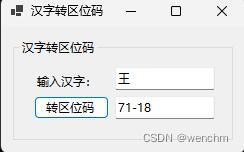C#中汉字转区位码
2024-01-03 06:06:36
目录
一、关于区位码?
1.区位码定义
????????区位码是一个4位的十进制数,每个区位码都对应着一个唯一的汉字,区位码的前两位叫做区码,后两位叫做位码。
2.算法
????????首先通过Encoding对象的GetBytes方法得到汉字的字节数组,将字节数组的第一位和第二位分别转换为整型数值,然后将得到的两个整型数值分别减160后转换为字符串,连接两个字符串就组成了汉字区位码。
string P_Chinese ="科";
byte[]?P_bt_array =Encoding.Default.GetBytes(Chinese);
short front =(short)(P_bt_array[0]-’\0’); //将字节数组的第一位转换成short类型
short back =(short)(P_bt_array[1]-’\0’); //将字节数组的第二位转换成short类型
string P_Result =(front -160).ToString()+(back-160).ToString();????????Encoding对象的GetBytes方法提供了多个重载,可以接收字符串、字符数组等对象。
可以使用FileStream对象将字节数组写入文件。
????????使用Encoding对象的GetBytes方法可以得到字符串对象的字节数组,现在可以创建一个FileStream对象,方便地将字节数组写入文件中。同样地,可以从文件中读取字节数组,然后调用Encoding对象的GetString方法将字符数组转换为字符串。
二、实例
//汉字与区位码的转换
using System.Text;
namespace _037
{
public partial class Form1 : Form
{
private GroupBox? groupBox1;
private TextBox? textBox2;
private Button? button1;
private TextBox? textBox1;
private Label? label1;
public Form1()
{
InitializeComponent();
Load += Form1_Load;
}
private void Form1_Load(object? sender, EventArgs e)
{
//
// textBox2
//
textBox2 = new TextBox
{
Location = new Point(102, 57),
Name = "textBox2",
Size = new Size(100, 23),
TabIndex = 3
};
//
// button1
//
button1 = new Button
{
Location = new Point(21, 57),
Name = "button1",
Size = new Size(75, 23),
TabIndex = 2,
Text = "转区位码",
UseVisualStyleBackColor = true
};
button1.Click += Button1_Click;
//
// textBox1
//
textBox1 = new TextBox
{
Location = new Point(102, 28),
Name = "textBox1",
Size = new Size(100, 23),
TabIndex = 1
};
//
// label1
//
label1 = new Label
{
AutoSize = true,
Location = new Point(21, 34),
Name = "label1",
Size = new Size(68, 17),
TabIndex = 0,
Text = "输入汉字:"
};
//
// groupBox1
//
groupBox1 = new GroupBox
{
Location = new Point(12, 12),
Name = "groupBox1",
Size = new Size(220, 102),
TabIndex = 0,
TabStop = false,
Text = "汉字转区位码"
};
groupBox1.SuspendLayout();
groupBox1.Controls.Add(textBox2);
groupBox1.Controls.Add(button1);
groupBox1.Controls.Add(textBox1);
groupBox1.Controls.Add(label1);
//
// Form1
//
AutoScaleDimensions = new SizeF(7F, 17F);
AutoScaleMode = AutoScaleMode.Font;
ClientSize = new Size(244, 126);
Controls.Add(groupBox1);
Name = "Form1";
StartPosition = FormStartPosition.CenterScreen;
Text = "汉字转区位码";
groupBox1.ResumeLayout(false);
groupBox1.PerformLayout();
}
private void Button1_Click(object? sender, EventArgs e)
{
if (textBox1!.Text != string.Empty) //判断输入是否为空
{
try
{
textBox2!.Text = //得到汉字区位码信息
GetCode(textBox1.Text);
}
catch (IndexOutOfRangeException ex)
{
MessageBox.Show( //使用消息对话框提示异常信息
ex.Message + "请输入正确的汉字", "出错!");
}
}
else
{
MessageBox.Show("请输入正确的汉字", "提醒!");
}
}
/// <summary>
/// 得到汉字区位码方法
/// </summary>
/// <param name="strChinese">汉字字符</param>
/// <returns>返回汉字区位码</returns>
public static string GetCode(string Chinese)
{
byte[] byte_array = Encoding.Default.GetBytes(Chinese); //字符串转Byte数组
int front = (short)(byte_array[0] - '\0'); //将字节数组的第一位转换成short类型
int back = (short)(byte_array[1] - '\0'); //将字节数组的第二位转换成short类型
return (front - 160).ToString() + (back - 160).ToString();//计算并返回区位码
}
}
}
三、生成效果
?
四、程序中的知识点
1.byte[] GetBytes(string s)
?????????用途:字符串转Byte数组
?public virtual byte[] GetBytes(string s)
?{
? ? ?if (s == null)
? ? ?{
? ? ? ? ?throw new ArgumentNullException("s", Environment.GetResourceString("ArgumentNull_String"));
? ? ?}
? ? ?int byteCount = GetByteCount(s);
? ? ?byte[] array = new byte[byteCount];
? ? ?int bytes = GetBytes(s, 0, s.Length, array, 0);
? ? ?return array;
?}//使用UTF-8的字符集,将字符串转换为字节数组
byte[]utf8 =Encoding.UTF8.GetBytes(str);2.字节数组转short类型
文章来源:https://blog.csdn.net/wenchm/article/details/135350559
本文来自互联网用户投稿,该文观点仅代表作者本人,不代表本站立场。本站仅提供信息存储空间服务,不拥有所有权,不承担相关法律责任。 如若内容造成侵权/违法违规/事实不符,请联系我的编程经验分享网邮箱:veading@qq.com进行投诉反馈,一经查实,立即删除!
本文来自互联网用户投稿,该文观点仅代表作者本人,不代表本站立场。本站仅提供信息存储空间服务,不拥有所有权,不承担相关法律责任。 如若内容造成侵权/违法违规/事实不符,请联系我的编程经验分享网邮箱:veading@qq.com进行投诉反馈,一经查实,立即删除!